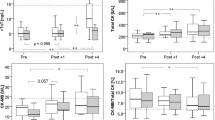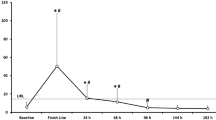Abstract
Background
The reasons for the appearance of cardiacspecific troponin (cTnT) after strenuous exercise are unclear. The aim of the present study was to evaluate the cardiospecificity of the 3rd generation cardiac cTnT assay during and after an ultra-endurance race of 216 km at extreme environmental conditions in Death Valley.
Study design and methods
We measured serially cTnT, creatine kinase (CK), activity and mass of the isoenzyme MB of CK (CK-MBact and CK-MBmass), and myoglobin in 10 well-trained athletes before, repeatedly during and after the race.
Results
Six of 10 participants finished the race within a preset time of 60 hours. Postrace values of biochemical markers CK, CK-MBact, CKMBmass, and myoglobin were significantly increased compared to baseline (p<0.05). CK-MBact increased from (median (25th/ 75thpercentile) 12 (10/13) U/L to 72 (32/110) U/L, CK-MBmass from 3.9 (2.9/5.6) U/L to 65 (18/80) U/L and CK increased from median 136 (98/ 228) U/L to 3,570 (985/6,884) U/L respectively. Pre-race myoglobin was 27 (22/31) µg/l compared to 530 (178/657) µg/l after the run. One runner developed significant exercise-induced rhabdomyolysis with spontaneous recovery. cTnT values remained below the 99th percentile reference limit in all athletes including the runner who developed significant rhabdomyolysis (peak CK 27,951 U/L).
Conclusions
Strenuous endurance exercise, even under extreme environmental conditions, does not result in structural myocardial damage in well-trained ultra-endurance athletes. We found no crossreactivity between cTnT and CK, neither in exercise-induced skeletal muscle trauma nor after rhabdomyolysis underscoring the excellent analytical performance of 3rd generation cTnT assay.
Similar content being viewed by others
References
Apple FS, Quist HE, Otto AP, Mathews WE, Murakami MM (2002) Release characteristics of cardiac biomarkers and ischemia-modified albumin as measured by the albumin cobalt- binding test after a marathon race. Clin Chem 48:1097–1100
Chen Y, Serfass RC, Mackey-Bojack SM, Kelly KL, Titus JL, Apple FS (2000) Cardiac troponin T alterations in myocardium and serum of rats after stressful, prolonged intense exercise. J Appl Physiol 88:1749–1755
Chen YJ, Serfass RC, Apple FS (2000) Loss of myocardial CK-MB into the circulation following 3.5 hours of swimming in a rat model. Int J Sports Med 21:561–565
Cummins P, Young A, Auckland ML, Michie CA, Stone PC, Shepstone BJ (1987) Comparison of serum cardiac specific troponin-I with creatine kinase, creatine kinase-MB isoenzyme, tropomyosin, myoglobin and C-reactive protein release in marathon runners: cardiac or skeletal muscle trauma? Eur J Clin Invest 17:317–324
Fallon KE, Sivyer G, Sivyer K, Dare A (1999) The biochemistry of runners in a 1600 km ultramarathon. Br J Sports Med 33:264–269
Fishbein MC, Wang T, Matijasevic M, Hong L, Apple FS (2003) Myocardial tissue troponins T and I. An immunohistochemical study in experimental models of myocardial ischemia. Cardiovasc Pathol 12:65–71
Herrmann M, Scharhag J, Miclea M, Urhausen A, Herrmann W, Kindermann W (2003) Post-race kinetics of cardiac troponin T and I and N-terminal pro-brain natriuretic peptide in marathon runners. Clin Chem 49:831–834
Konig D, Schumacher YO, Heinrich L, Schmid A, Berg A, Dickhuth HH (2003) Myocardial stress after competitive exercise in professional road cyclists. Med Sci Sports Exerc 35:1679–1683
Kratz A, Lewandrowski KB, Siegel AJ, Chun KY, Flood JG, Van Cott EM, Lee-Lewandrowski E (2002) Effect of marathon running on hematologic and biochemical laboratory parameters, including cardiac markers. Am J Clin Pathol 118:856–863
Lyon ME, Ball CL, Krause RD, Slotsve GA, Lyon AW (2004) Effect of haemolysis on cardiac troponin T determination by the Elecsys 2010 immunoanalyzer. Clin Biochem 37:698–701
Maron BJ, Poliac LC, Roberts WO (1996) Risk for sudden cardiac death associated with marathon running. J Am Coll Cardiol 28:428–431
Maron BJ, Shirani J, Poliac LC, Mathenge R, Roberts WC, Mueller FO (1996) Sudden death in young competitive athletes. Clinical, demographic, and pathological profiles. JAMA 276:199–204
Muller-Bardorff M, Weidtmann B, Giannitsis E, Kurowski V, Katus HA (2002) Release kinetics of cardiac troponin T in survivors of confirmed severe pulmonary embolism. Clin Chem 48:673–675
Muller-Bardorff M, Freitag H, Scheffold T, Remppis A, Kubler W, Katus HA (1995) Development and characterization of a rapid assay for bedside determinations of cardiac troponin T. Circulation 92:2869–2875
Neumayr G, Gaenzer H, Pfister R, Sturm W, Schwarzacher SP, Eibl G, Mitterbauer G, Hoertnagl H (2001) Plasma levels of cardiac troponin I after prolonged strenuous endurance exercise. Am J Cardiol 87:369–371, A10
Neumayr G, Pfister R, Mitterbauer G, Maurer A, Gaenzer H, Sturm W, Hoertnagl H (2002) Effect of the “Race Across The Alps — in elite cyclists on plasma cardiac troponins I and T. Am J Cardiol 89:484–486
Noakes TD (1987) Heart disease in marathon runners: a review. Med Sci Sports Exerc 19:187–194
Noakes TD, Opie LH, Rose AG, Kleynhans PH, Schepers NJ, Dowdeswell R (1979) Autopsy-proved coronary atherosclerosis in marathon runners. N Engl J Med 301:86–89
Rifai N, Douglas PS, O’Toole M, Rimm E, Ginsburg GS (1999) Cardiac troponin T and I, echocardiographic [correction of electrocardiographic] wall motion analyses, and ejection fractions in athletes participating in the Hawaii Ironman Triathlon. Am J Cardiol 83:1085–1089
Scharhag J, Schneider G, Urhausen A, Rochette V, Kramann B, Kindermann W (2002) Athlete’s heart: right and left ventricular mass and function in male endurance athletes and untrained individuals determined by magnetic resonance imaging. J Am Coll Cardiol 40:1856–1863
Shave RE, Dawson E, Whyte PG, George K, Ball D, Gaze CD, Collinson P (2003) Cardiac troponin T in female athletes during a two-day mountain marathon. Scott Med J 48:41–52
Shave R, Dawson E, Whyte G, George K, Ball D, Collinson P, Gaze D (2002) The cardiospecificity of the thirdgeneration cTnT assay after exerciseinduced muscle damage. Med Sci Sports Exerc 34:651–654
Siegel AJ, Sholar M, Yang J, Dhanak E, Lewandrowski KB (1997) Elevated serum cardiac markers in asymptomatic marathon runners after competition: is the myocardium stunned? Cardiology 88:487–491
Snyder JA, Rogers MW, King MS, Phillips JC, Chapman JF, Hammett- Stabler CA (2004) The impact of haemolysis on Ortho-Clinical Diagnostic’s ECi and Roche’s elecsys immunoassay systems. Clin Chim Acta 348:181–187
Urhausen A, Scharhag J, Herrmann M, Kindermann W (2004) Clinical significance of increased cardiac troponins T and I in participants of ultra- endurance events. Am J Cardiol 94:696–698
Urhausen A, Kindermann W (1992) Echocardiographic findings in strength- and endurance-trained athletes. Sports Med 13:270–284
Author information
Authors and Affiliations
Corresponding author
Rights and permissions
About this article
Cite this article
Roth, H.J., Leithäuser, R.M., Doppelmayr, H. et al. Cardiospecificity of the 3rd generation cardiac troponin T assay during and after a 216 km ultra-endurance marathon run in Death Valley. Clin Res Cardiol 96, 359–364 (2007). https://doi.org/10.1007/s00392-007-0509-9
Received:
Accepted:
Published:
Issue Date:
DOI: https://doi.org/10.1007/s00392-007-0509-9




